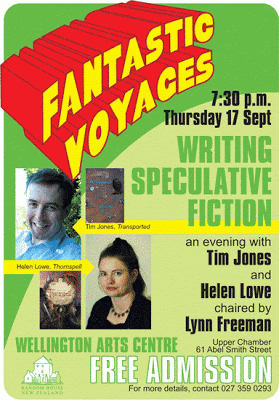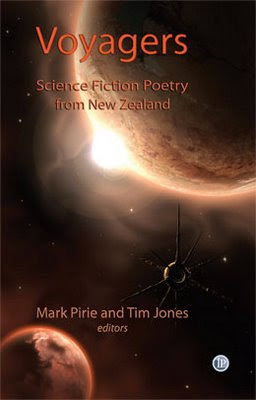Here is the press release for Fantastic Voyages: Writing Speculative Fiction, which is happening in Wellington this Thursday evening. If you’re interested in reading, writing or publishing science fiction or fantasy, this is the place to be!
Fantastic Voyages:
Two Breakthrough NZ Writers
Talk About Their Love of SciFi-Fantasy:
An Evening with Tim Jones & Helen Lowe, chaired by Lynn Freeman
7.30-9pm, Thursday 17 September
Double Sir Julius Vogel Award winning author, Helen Lowe, and author, anthologist and editor, Tim Jones, are getting together on Thursday 17 September in an evening event chaired by Radio New Zealand’s Lynn Freeman, to talk about their love of writing science fiction and fantasy, the challenges and rewards of being a speculative fiction writer, and how they’ve gone about getting published, both in NZ and overseas.
Tim Jones is a Wellington based writer, editor and literary blogger whose short story collection Transported (Vintage, 2008) ties together speculative fiction, which encompasses science fiction, fantasy and horror, and literary fiction in one collection. Transported was longlisted for the 2008 Frank O’Connor International Short Story Award and a science fiction story from the collection, “The New Neighbours”, is included in the recently released Penguin Book of Contemporary New Zealand Short Stories.
Helen Lowe’s first novel, Thornspell, is published by Knopf (Random House Children’s Books) in the United States and is a Storylines Notable Book 2008 as well as winning the Sir Julius Vogel Award 2009 for Best Novel: Young Adult. Lowe also won the Sir Julius Vogel award for Best New Talent and has the first book in an epic Fantasy quartet, The Wall of Night, coming out with Eos (HarperCollins USA) in September 2010.
In the past, speculative fiction has tended to fly beneath the radar on the NZ writing scene. “But that’s changing fast,” says Jones. “The barriers that have divided speculative fiction from literary fiction are coming down and there is now a thriving New Zealand speculative fiction scene, with many writers of SF, Fantasy and Horror for adults now coming through to join the growing numbers writing speculative fiction for children and young adults.”
Lowe agrees. “And I’m finding that there’s a hunger out there, especially amongst younger readers and writers who love the genre, to find out how to go about writing SciFi-Fantasy successfully and get it published. So Tim and I thought, why not get together and talk about why we love writing speculative fiction and how we’ve gone about things, as well as sharing some of our own work.”
The event, which is supported by Random House New Zealand & Unity Books, is being held on Thursday September 17 at 7.30 pm in the Upper Chamber, Wellington Arts Centre/Toi Poneke, 61 Abel Smith Street in central Wellington. Admission is free.
For further information, contact senjmito (at) gmail.com
All welcome!





